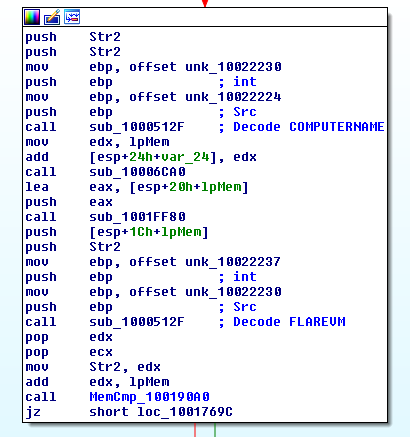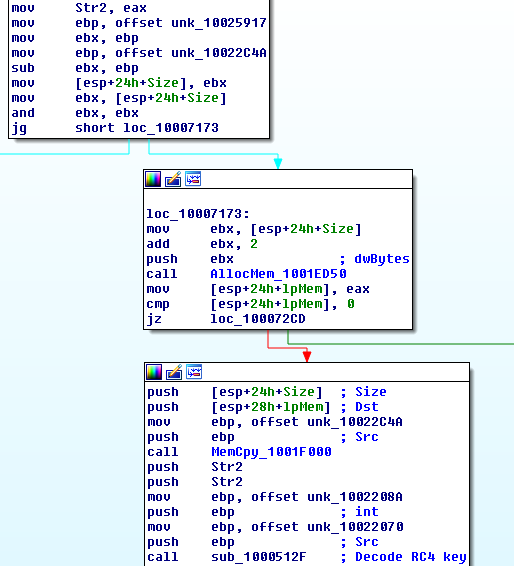A Relook at the TerraLoader Dropper DLL
The malware author responsible for the TerraLoader, who is believed to be BadBullzVenom[4] after a disagreement between the actor and customer took place on an underground forum market place, appears to have been happily updating their delivery system again referred to as TerraLoader. An excellent report was posted online by Twitter user @Arkbird_SOLG [1,5] using a sample discovered by @malz_intel. The report was well done so this is mostly an addendum of my reverse engineering notes after analyzing the aforementioned sample in the report[2] where I primarily focus on the DLL that will build and deliver the javascript backdoor commonly referred to as ‘more_eggs’.
Initial Overview
This is just a quick overview getting to the DLL portion, as aforementioned it is already covered in previous research[1].
Scriptlet:
MD5: f93fdcf5856feb254a26547dc8c2b671
SHA1: 1c038a86b337cf72663da5b6780d34ba0fb1c0c9
SHA256: 000a5e63109b3c653d63d84d03fe474242b987bfadda9aeaa200653fd2155a31
Scriptlet decodes out a DOC file and a DLL, the doc file appears to be a distraction from the loading of the DLL.
Doc: 11e54f594949a4c7f13e85b4ac2cbd555200ac34e6d61b58a71fbcfccc0497cd
DLL: fb55b26b8edee2431b35d0e28df5f223510a15344ede400a2f5c04a0d45e6b77
String Encoding Updates
The string encoding is a bit different now, the dropper DLL portion has always utilized a simple XOR based routine for bruting out its own string encoding key while also leveraging various secondary routines to use the key once found(XOR, AES, RC4). The author has moved to using RC4 for bruting out the string encoding key which makes the entire process take longer now but has the added benefit of acting as a sleep routine as well.
The sample takes three pieces of data, data that is encrypted, a starting RC4 key string and the data that will be decrypted to check that the correct key has been found.
Encrypted data:
b8e0ce81bcd3023bf5e2b37d3e1c801d99bd3f7f408c87b7923673d7840797a024f78d62552de17aba3d10c4
Starting RC4 key:
SouXRE
Decrypted data:
b92fe2de81d94d05b0431c545221cfbc23ad2f47a9279a20498948b9d4b3ffdf4b22669a1eace7a3b14862d2
The bruting routine works by simple using an iterator starting at 0 and converting the integer value into a string, appending it to the starting key, decrypting the encrypted data and checking that the output matches the decrypted data. If it doesn’t match the iterator is incremented and the process starts over again until the match is found.
If you understand how encryption algorithms work then you can see a flaw in this from a static reverse engineering perspective we can actually recover enough of the keystream data to decode out most of the strings on board without needing to brute force the key.
encoded_data ^ decoded_data = partial RC4 XOR Keystream
Using this knowledge we can recover part of the RC4 XOR keystream:
01cf2c5f3d0a4f3e45a1af296c3d4fa1ba101038e9ab1d97dbbf3b6e50b4687f6fd5ebf84b8106d90b757216
Using that data we can decode out most of the strings from the sample which all line up with previously listed strings, the malware is basically designed to build out the more_eggs backdoor for dropping to disk and detonating.
Partial strings for reference:
%APPDATA%
/B /e:jsCript
msxsl.exe
CED1712A510453BEE1F83F8AE7
a2service.exe
schtasks.exe
/Create /TN
UserInitMprLogonScript
PROCESSOR_IDENTIFIER
.ComputerName +
COMPUTERNAME
FLAREVM
USERNAME
Notepad
Data Encoding Updates
As mentioned by the earlier referenced blog post author this new backdoor is actually dropped by being encoded with the addition of computer based information added to the key, this makes it more difficult to recover the backdoor unless you know the computer name and processor information of the system it was dropped on.
We can see evidence of this in the partial strings above showing the ‘PROCESSOR_IDENTIFIER’ and ‘COMPUTERNAME’ along with ‘.ComputerName +’ which will be used by parts of the wrapper on the backdoor to decode out the backdoor. If the Dropper DLL is responsible for this piece then the backdoor must exist somewhere in the DLL:
In the screenshot above we can see a large block of data has the size calculated, memory allocated, copied into the new memory and then the string ‘CED1712A510453BEE1F83F8AE7’ is decrypted. Right after this a call to the RC4 routine takes place:

After calling RC4, labeled ‘RC4_maybe’ because this picture was taken while I was still mapping out the sample, a call to an onboard DEFLATE routine takes place. Let’s check what is decoded:
>>> key = 'CED1712A510453BEE1F83F8AE7'
>>> from Crypto.Cipher import ARC4
>>> rc4 = ARC4.new(key)
>>> t = rc4.decrypt(data)
>>> import zlib
>>> t[:50]
'\xed}kw#7\xae\xe0g\xe7\x9c\xfc\x87\x8a\xee\x9d\xb44\xed\x96\xeb\xa1g\x94\xce\xac^N\xf7\xa6\x1f\xbe\xb6;\x99\x99v\x8fW\x96\xcav\xa5\xa5*\xa5T\xb6\xe5v'
>>> t2 = zlib.decompress(t,-15)
>>> t2[:100]
'var BV = "6.6b";\r\nvar Gate = "https://d27qdop2sa027t.cloudfront.net/spmar/d9264";\r\nvar hit_each = 10'
Later in the sample we can also recover the decoding of MSXSL EXE file as well:
>>> key = 'CED1712A510453BEE1F83F8AE7'
>>> from Crypto.Cipher import ARC4
>>> rc4 = ARC4.new(key)
>>> t = rc4.decrypt(data1)
>>> import zlib
>>> t2 = zlib.decompress(t,-15)
>>> t2[:100]
'MZ\x90\x00\x03\x00\x00\x00\x04\x00\x00\x00\xff\xff\x00\x00\xb8\x00\x00\x00\x00\x00\x00\x00@\x00\x00\x00\x00\x00\x00\x00\x00\x00\x00\x00\x00\x00\x00\x00\x00\x00\x00\x00\x00\x00\x00\x00\x00\x00\x00\x00\x00\x00\x00\x00\x00\x00\x00\x00\xd8\x00\x00\x00\x0e\x1f\xba\x0e\x00\xb4\t\xcd!\xb8\x01L\xcd!This program cannot be'
Also a part of the XML for task scheduling:
<?xml version="1.0" encoding="UTF-16"?>
<Task version="1.2" xmlns="http://schemas.microsoft.com/windows/2004/02/mit/task">
<RegistrationInfo>
<Author>SYSTEM</Author>
</RegistrationInfo>
<Triggers>
<BootTrigger>
<Enabled>true</Enabled>
</BootTrigger>
</Triggers>
<Principals>
<Principal id="Author">
<UserId>S-1-5-18</UserId>
<RunLevel>HighestAvailable</RunLevel>
</Principal>
</Principals>
<Settings>
<MultipleInstancesPolicy>IgnoreNew</MultipleInstancesPolicy>
<DisallowStartIfOnBatteries>false</DisallowStartIfOnBatteries>
<StopIfGoingOnBatteries>false</StopIfGoingOnBatteries>
<AllowHardTerminate>true</AllowHardTerminate>
<StartWhenAvailable>true</StartWhenAvailable>
<RunOnlyIfNetworkAvailable>false</RunOnlyIfNetworkAvailable>
<IdleSettings>
<StopOnIdleEnd>false</StopOnIdleEnd>
<RestartOnIdle>false</RestartOnIdle>
</IdleSettings>
<AllowStartOnDemand>true</AllowStartOnDemand>
<Enabled>true</Enabled>
<Hidden>false</Hidden>
<RunOnlyIfIdle>false</RunOnlyIfIdle>
<WakeToRun>true</WakeToRun>
<ExecutionTimeLimit>PT0S</ExecutionTimeLimit>
<Priority>7</Priority>
</Settings>
<Actions Context="Author">
<Exec>
<Command>cscripT</Command>
<Arguments>
One of the strings also stands out as I don’t remember seeing it in these samples before ‘FLAREVM’. FlareVM is a malware analysis creation system that FireEye released which allows for the quick creation of a virtual machine for malware analysis[3] and the dropper appears to be checking if the computer name is FLAREVM:

I haven’t verified if the sample will fail to infect as I am still in the process of statically mapping out the updated sample but this check function does happen before the backdoor is decoded:

References
- https://twitter.com/Arkbird_SOLG/status/1375945806474317831
- https://app.any.run/tasks/b1d3a533-912b-4fe9-86cc-69d4bda40453/
- https://www.fireeye.com/blog/threat-research/2017/07/flare-vm-the-windows-malware.html
- https://malpedia.caad.fkie.fraunhofer.de/actor/venom_spider
- https://github.com/StrangerealIntel/CyberThreatIntel/blob/master/Additional%20Analysis/Terraloader/2021-03-25/Analysis.md
A RE look at the TerraLoader Dropper DLL was originally published in Walmart Global Tech Blog on Medium, where people are continuing the conversation by highlighting and responding to this story.
Article Link: https://medium.com/walmartglobaltech/a-re-look-at-the-terraloader-dropper-dll-e5947ad6e244?source=rss----905ea2b3d4d1---4

